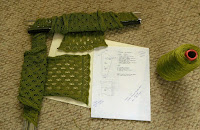That’s what going on here lately! After finishing up the 1RT Pinkie I jumped right into using that marsh Cannelé that was gifted to me a while ago, still wanting that long, lace, button-front hoodie. https://knitwords.blogspot.com/2022/02/my-hole-theory.html I had made several lace swatches in Cannelé, found some of them to be too stiff and was waffling, finally settling on this one – I had used it way back in Knitwords #32, Black Cherry, in Wool Crepe Deluxe and, after swatching with the mercerised cotton and going with a larger stitch size, T7, resulted in a gauge of 27 sts and 40 rows, which gave lovely large holes. Previously, swatching at T6, like Borderline, from Knitwords #25 https://knitwords.blogspot.com/2014/04/kinky-knitting.html with the gauge being 30 sts and 42 rows, it gave a crispness to the fabric that I didn’t really want this time.
Deciding upon the lace pattern was one thing but I also wanted to change up the hems a bit and, like I told you, I get hung up on something and have to re-work it over and over to get it out of my system, so went with that knitted-back wrap cast-on in another way. Paired it up with my #21 50 Ways re-do http://knitwords.blogspot.com/2020/06/better-late-than-never.html and here’s what happened!
21b. KNITTED-BACK WRAP Cast-ON, LACE EDGE, HAND
TRANSFERRED. 8 stitch repeat, side away is right side.
1. Add extra
stitch at right edge. Cast-on waste yarn, ravel cord. RC000. CAR. Measure out MC 6X width of ns in
work. Double it over on itself to have 2 strands together.
2. Using MC double
strand, place loop on left end needle. take both strands under and to the left,
then back up, over 2nd needle and back into hook of first needle. Push back on
needle butt to knit both strands through, making about main tension-size
stitch. Repeat across row.
3. Single
strand, MT-1, knit 2 rows.
4. #1 right is
the centre of the 8-st repeat. Beginning with #2 right, transfer this stitch to
#1 right, repeat across row to have 2 sts on every other needle. Leave empty ns in work. Knit 2 rows. RC004
5. Using
3-prong tool, transfer as in chart, starting with#1 right as the centre with 3
stitches together. Knit 2 rows. RC006
6. Transfer as
in chart, using 2-prong tool. Knit 2
rows. RC008
7. 1-prong
tool transfer as in chart. K2R. RC010
8. Make a tuck
stitch border as follows: set to hold. Select #1 left and then bring EON to HP.
9. Knit 2
rows. RC012.
10. Cancel
hold. Carefully bring all ns out, making sure not to disturb the held sts. Knit
1 row. RC013. Set to MT. Continue in desired stitch. Remove WY and allow
wrapped edge to curl forward on the knit side.
It looks like a chained cast-on!

.jpg)



